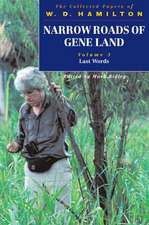Extinction Rates
Editat de John H. Lawton, Robert M. Mayen Limba Engleză Paperback – 12 ian 1995
Preț: 560.51 lei
Preț vechi: 850.32 lei
-34% Nou
Puncte Express: 841
Preț estimativ în valută:
107.27€ • 111.57$ • 88.56£
107.27€ • 111.57$ • 88.56£
Carte tipărită la comandă
Livrare economică 04-10 aprilie
Preluare comenzi: 021 569.72.76
Specificații
ISBN-13: 9780198548294
ISBN-10: 019854829X
Pagini: 246
Ilustrații: line figures, tables
Dimensiuni: 156 x 234 x 14 mm
Greutate: 0.36 kg
Ediția:New.
Editura: OUP OXFORD
Colecția OUP Oxford
Locul publicării:Oxford, United Kingdom
ISBN-10: 019854829X
Pagini: 246
Ilustrații: line figures, tables
Dimensiuni: 156 x 234 x 14 mm
Greutate: 0.36 kg
Ediția:New.
Editura: OUP OXFORD
Colecția OUP Oxford
Locul publicării:Oxford, United Kingdom
Recenzii
'EXTINCTION RATES is a breath of fresh air ... EXTINCTION RATES is a gold-mine of hard data and solid science which should be read by all with a serious interest in biodiversity -- past, present, and future.'David M. Raup, University of Chicago, Science
a well integrated set of 14 research articles and reviews that attempt to put the study of extinction rates on a more rigorous footing ... Extinction Rates is a gold mine of hard data and solid science that should be read by all with a serious interest in biodiversity - past, present and future.
The last book we looked at, Extinction Rates, is without doubt the cream of a bumper crop.
I would strongly recommend Extinction Rates to all those listed as being the target audience on the back cover (senior undergraduates, postgraduate students, and research workers in the general fields of ecology, conservation biology and the environmental sciences). It would make an extremely good basis for a final year undergraduate course, or for a graduate school discussion class. I suspect that a wider audience would also gain from reading it.
a well integrated set of 14 research articles and reviews that attempt to put the study of extinction rates on a more rigorous footing ... Extinction Rates is a gold mine of hard data and solid science that should be read by all with a serious interest in biodiversity - past, present and future.
The last book we looked at, Extinction Rates, is without doubt the cream of a bumper crop.
I would strongly recommend Extinction Rates to all those listed as being the target audience on the back cover (senior undergraduates, postgraduate students, and research workers in the general fields of ecology, conservation biology and the environmental sciences). It would make an extremely good basis for a final year undergraduate course, or for a graduate school discussion class. I suspect that a wider audience would also gain from reading it.











